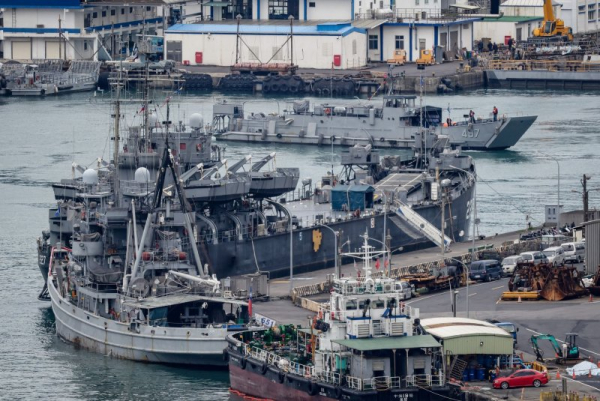

Taiwan Navy vessels, including a landing craft (top), maneuver in Keelung harbor, in Keelung City in northern Taiwan on Wednesday as major joint-force exercises by the Chinese military around the democratically-ruled island entered their second day. Photo by Ritchie B. Tongo/EPA-EFE
The United States doubled down on its decades-old support for Taiwan as China flexed its muscles with a second day of large-scale military exercises around Taiwan, including live-fire drills, it said were intended to teach the self-governing island a lesson.
In a statement issued after Chinese forces launched the surprise drills in the sea and skies around the self-governing island Tuesday, the U.S. State Department accused China of ramping up tensions and jeopardizing regional security with its “aggressive military activities and rhetoric toward Taiwan.” Advertisement
“In the face of China’s intimidation tactic and destabilizing behavior, the United States’ enduring commitment to our allies and partner, including Taiwan, continues,” State Department spokesperson Tammy Bruce said.
“The United States supports peace and stability across the Taiwan Strait and opposes unilateral changes to the status quo, including through force or coercion.” Advertisement
The People’s Liberation Army Eastern Theater Command said day two of the joint Navy, Army and Rocket forces maneuvers saw the group conduct simulated “precision strikes” on key targets, including ports and energy infrastructure as part of exercise “Strait Thunder-2025 A,” which it said were successful.
Senior Col. Shi Yi said the drills also put the joint blockade and control capabilities of the various forces to the test in the Taiwan Strait in waters west and south of the island.
However, Shi stressed that the “live-fire strike drills” by ground forces using long-range rocket artillery systems were conducted further north in the East China Sea, within designated fire zones.
Taiwan’s Defense Ministry said Wednesday’s early-morning maneuvers involved 76 aircraft and 19 PLA Navy ships and other Chinese vessels, similar numbers to Tuesday when the Chinese forces massed around Taiwan without prior warning.
The ministry, which said drills also took place east of the island in and over the Philippine Sea, said its forces were on high alert in the face of what is said was China’s “aggressive, provocative and irresponsible” behavior.
The PLA took to social media as the drills got underway Tuesday saying they were “a stern warning and forceful deterrence against ‘Taiwan Independence’ separatist forces,” a response fully justified by the legitimate need to protect “China’s sovereignty and national unity.” Advertisement
Analysts at the Eurasia Group told CNBC China was angered by a speech by Taiwan President William Lai last month in which he accused Beijing of attempting to interfere in Taiwan’s democracy and called for a legal and economic effort to fend off its attempts to infiltrate.
Beijing was forced to postpone its response due to the China Development Forum last week, a two-day event attended by CEOs of top American and European multinationals, including Apple’s Tim Cook and Pascal Soriot of AstraZeneca — plus the presence in the region of U.S. Defense Secretary Pete Hegseth making his first swing through the Asia-Pacific since taking over at the Pentagon on Jan. 25.
Hegseth further ruffled feathers within the Chinese Communist Party leadership by reiterating the United States’ commitment to counter “China’s aggression” in the region by re-establishing deterrence and praising Japan as an “indispensable partner in deterring communist Chinese military aggression,” including in the Taiwan Strait.
Hegseth made the comments while in the Philippines on Friday.
Cornell University Military History and Policy Professor David Silbey told CNBC that the exercises were both China intimidating Taiwan and preparation for potentially re-taking it by force, which Beijing has consistently refused to rule out. Advertisement